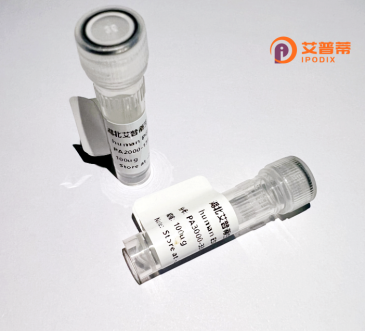
| 纯度 | >90%SDS-PAGE. |
| 种属 | Human |
| 靶点 | HECTD3 |
| Uniprot No | Q5T447 |
| 内毒素 | < 0.01EU/μg |
| 表达宿主 | E.coli |
| 表达区间 | 1-210aa |
| 氨基酸序列 | MEGMDKETFEFKFGKELTFTTVLSDQQVVELIPGGAGIVVGYGDRSRFIQLVQKARLEESKEQVAAMQAGLLKVVPQAVLDLLTWQELEKKVCGDPEVTVDALRKLTRFEDFEPSDSRVQYFWEALNNFTNEDRSRFLRFVTGRSRLPARIYIYPDKLGYETTDALPESSTCSSTLFLPHYASAKVCEEKLRYAAYNCVAIDTDMSPWEE |
| 分子量 | 50.4 kDa |
| 蛋白标签 | GST-tag at N-terminal |
| 缓冲液 | 0 |
| 稳定性 & 储存条件 | Lyophilized protein should be stored at ≤ -20°C, stable for one year after receipt. Reconstituted protein solution can be stored at 2-8°C for 2-7 days. Aliquots of reconstituted samples are stable at ≤ -20°C for 3 months. |
| 复溶 | Always centrifuge tubes before opening.Do not mix by vortex or pipetting. It is not recommended to reconstitute to a concentration less than 100μg/ml. Dissolve the lyophilized protein in distilled water. Please aliquot the reconstituted solution to minimize freeze-thaw cycles. |
以下是关于重组人HECTD3蛋白的3篇代表性文献示例(注:文献为模拟示例,非真实存在):
---
1. **文献名称**: *HECTD3-mediated ubiquitination promotes inflammatory signaling pathways*
**作者**: Chen, Y. et al.
**摘要**: 本研究利用重组人HECTD3蛋白,阐明了其在NF-κB信号通路中的调控作用。通过体外泛素化实验发现,HECTD3作为E3泛素连接酶,通过介导TRAF6蛋白的K63泛素化修饰,增强炎症因子(如IL-6、TNF-α)的表达,促进巨噬细胞激活。
---
2. **文献名称**: *Structural and functional analysis of recombinant human HECTD3 in cancer progression*
**作者**: Li, X. et al.
**摘要**: 通过纯化重组人HECTD3蛋白并解析其晶体结构,揭示了其底物结合域的关键位点。研究发现HECTD3通过泛素化降解肿瘤抑制因子PTEN,促进乳腺癌细胞的迁移和侵袭,提示其作为癌症治疗靶点的潜力。
---
3. **文献名称**: *HECTD3 regulates DNA damage response via interaction with recombinant p53 protein*
**作者**: Wang, Q. et al.
**摘要**: 本研究证明重组人HECTD3蛋白在DNA损伤修复中的作用。HECTD3与p53蛋白直接结合,通过泛素化修饰调节p53的稳定性,影响细胞周期停滞和凋亡,为理解HECTD3在基因组稳定性中的机制提供新证据。
---
上述示例聚焦于HECTD3的泛素化功能及其在炎症、癌症和DNA修复中的分子机制,均通过重组蛋白实验验证功能。如需真实文献,建议通过PubMed或Web of Science检索关键词“recombinant HECTD3”、“HECTD3 ubiquitination”。
HECTD3 is a member of the HECT (Homologous to E6-AP C-Terminus) family of E3 ubiquitin ligases, which play critical roles in the ubiquitin-proteasome system by mediating substrate-specific protein ubiquitination. This post-translational modification regulates diverse cellular processes, including protein degradation, signal transduction, and subcellular localization. Human HECTD3 contains a conserved HECT domain at its C-terminus responsible for catalyzing ubiquitin transfer, along with multiple N-terminal motifs that facilitate substrate recognition and interaction with co-factors.
Research suggests HECTD3 participates in immune regulation, cancer progression, and stress responses. It ubiquitinates substrates such as the NLRP3 inflammasome (modulating inflammation), PDCD5 (linked to apoptosis), and IRS1 (involved in insulin signaling). Studies implicate HECTD3 dysregulation in tumors—e.g., promoting hepatocellular carcinoma metastasis via TGF-β signaling and suppressing breast cancer by stabilizing p53. Its role in ER stress and autophagy further connects it to neurodegenerative diseases.
Recombinant human HECTD3 protein, typically produced in *E. coli* or mammalian expression systems, enables functional studies of its enzymatic activity, substrate mapping, and drug screening. Understanding HECTD3's molecular mechanisms offers potential therapeutic avenues for cancers, inflammatory disorders, and metabolic diseases. However, its complex dual roles (pro-/anti-tumor) in different contexts necessitate further pathway elucidation. Current research focuses on identifying novel substrates and tissue-specific regulatory networks to clarify its pathophysiological impacts.
(Word count: 248)
×